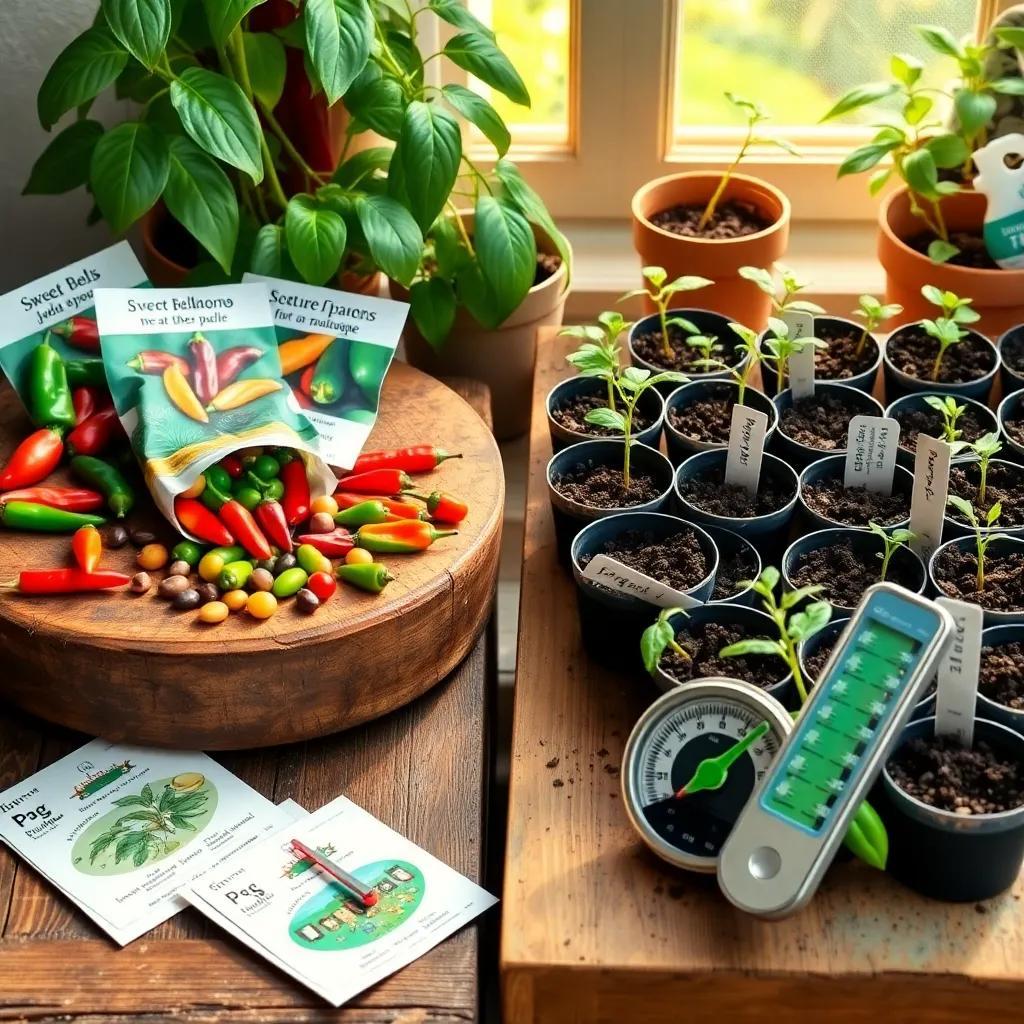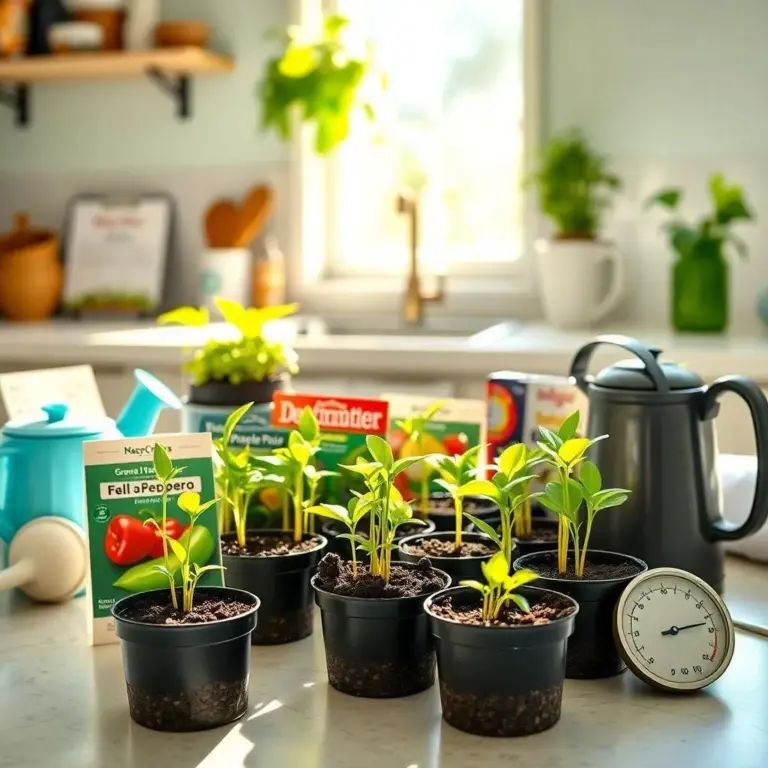Are you ready to dive into the exciting world of growing your own peppers? Whether you’re a seasoned gardener or just starting out, getting those seeds to sprout can feel like a mini adventure! Join me as we explore the secrets to successful pepper seed germination, tips to boost sprouting, and how to tackle any hiccups along the way. Let’s get our hands dirty and watch those little green gems come to life!
Factors Influencing Pepper Seed Germination Time
When it comes to pepper seed germination, several factors come into play that can make the difference between a sprouting success and a gardening flop. Understanding these elements can help me create the perfect environment for my precious seeds! So, what are these magical factors?
- Temperature: Pepper seeds love warmth! The ideal temperature for them to sprout is between 75°F to 85°F (24°C to 29°C). If it’s too cold, the seeds might just decide to take a nap instead of germinating. If it gets too hot, that can be a problem too! So, keeping an eye on the temperature is super important!
- Moisture: Ah, water! Seeds need it, but not too much! It’s like giving a plant a drink without drowning it. I need to keep my soil moist—not soggy! A good balance here is key because too much moisture can lead to nasty root rot.
- Soil Quality: The soil is like a cozy bed for our seeds. Using a well-draining soil mix that’s rich in organic matter will give my seeds the nutrients they crave and keep them comfy. Think of it like a five-star hotel for plants!
- Light: Here’s a fun fact: pepper seeds don’t need light to germinate! In fact, they prefer it dark. Planting them about 1/4 to 1/2 inch deep keeps them nice and cozy under a blanket of soil.
- Seed Quality: Just like picking fresh ingredients for a recipe, starting with high-quality seeds is essential! Using seeds from a trusted source ensures better germination rates and healthier plants.
By keeping these factors in mind, I’m bound to create the best conditions for my pepper seeds to sprout and flourish. Ready to see those little green shoots? I sure am!
Average Time for Different Pepper Varieties to Sprout
Now that we know what influences germination, let’s talk about the average time it takes for different pepper varieties to sprout! I can practically hear those seeds whispering, “Hurry up and grow!”
Most pepper seeds take about 7 to 14 days to germinate. However, some hot varieties, like habaneros and ghost peppers, are a bit more dramatic and might take around 2 to 3 weeks or even longer! Spoiler alert: sweet peppers like bell peppers usually sprout faster than their fiery counterparts.
Here’s a little breakdown of the germination times for different pepper varieties:
| Pepper Variety | Average Germination Time |
|————————-|——————————|
| Sweet Bell Peppers | 7-10 days |
| Jalapenos | 7-14 days |
| Habaneros | 14-21 days |
| Ghost Peppers | 14-21 days |
Why does this matter? Well, I need to be patient and not lose hope if I don’t see those sprouts right away! Higher temperatures can speed things up, while cooler conditions might slow them down.
So, as I wait, I remind myself: good things come to those who wait! Plus, I can use this time to plan my future pepper dishes and think about all the delicious meals I’ll make with those fresh peppers! How exciting is that?

Steps to Enhance Germination Rates for Pepper Seeds
If I want my pepper seeds to sprout like little green warriors, there are some simple steps I can follow to boost their chances of success. Here’s what I’ve learned to really get those seeds going!
- Choose High-Quality Seeds: Quality matters! I always pick fresh, healthy seeds from a reputable source. Seeds that are plump and firm are more likely to germinate well.
- Pre-soaking Seeds: Some gardeners swear by this trick! I soak my pepper seeds in warm water for 12 to 24 hours before planting. This little soak can soften the seed coat, making it easier for the seed to absorb water and sprout faster!
- Prepare the Soil: Using a well-draining soil mix is key! I like to fill my seed trays or pots with rich, organic soil that’s moist but not soggy. It’s like giving my seeds a comfy bed to rest in.
- Sow the Seeds: I make small indentations in the soil about 1/4 to 1/2 inch deep. Then, I drop in one or two seeds in each space. Just a thin layer of soil on top can keep them cozy!
- Humidity and Warmth: I place my trays in a warm spot where the temperature stays between 75°F to 85°F (24°C to 29°C). Covering the trays with plastic wrap or a humidity dome helps keep moisture in, creating a mini greenhouse effect.
- Monitor Moisture: I check the soil regularly to keep it consistently moist. A spray bottle can help me give them a gentle mist without flooding!
By following these steps, I can help ensure that my pepper seeds have the best shot at sprouting and growing into healthy plants. How exciting is that? I can’t wait to see those little greens poking up through the soil!
Common Issues and Solutions in Pepper Seed Germination
Germinating pepper seeds can be a fun adventure, but sometimes things don’t go as planned. Don’t worry—I’m here to help troubleshoot some common issues that might pop up along the way!
- Slow or Uneven Germination: If my seeds are taking longer than expected, the temperature could be the culprit. I check to make sure they’re warm enough, ideally between 75°F to 85°F. Using a seed-starting heat mat can work wonders!
- Fungal Growth: If I notice fuzzy spots or my seedlings collapsing, I might have overwatered. This can lead to a condition called damping-off. To fix this, I need to let the top layer of soil dry out a bit and ensure good airflow. Watering from the bottom can also help avoid this issue!
- Poor Seedling Growth: If my little seedlings look sad and yellow, they might not be getting enough light. I make sure they receive at least 12 to 16 hours of bright light daily. Using grow lights can give my plants the boost they need if natural light is lacking.
- Rotting Seeds: If I find my seeds have gone mushy, it’s usually a sign of poor seed quality or incorrect storage. I always make sure to buy fresh seeds and store them in a cool, dry place until I’m ready to plant.
- Pest Problems: Sometimes pesky bugs, like aphids, can invade my seedlings. I keep an eye out for these little buggers and use organic pest control methods if needed!
By being aware of these common issues, I can quickly address them and keep my pepper plants on track for a successful growing season. Gardening can throw some curveballs, but with a little patience and care, I can navigate those challenges!
Optimal Conditions for Successful Pepper Seed Sprouting
Creating optimal conditions for pepper seed sprouting is my ticket to a flourishing garden! Here’s how I can set the stage for my seeds to thrive.
- Temperature: As mentioned earlier, pepper seeds love warmth! I keep the soil temperature between 75°F and 85°F (24°C to 29°C). A consistent, warm environment encourages those seeds to sprout quickly. I often use a seedling heat mat for extra warmth if needed!
- Moisture: Keeping the soil consistently moist is vital. I water my seeds carefully to avoid oversaturation. A good rule of thumb is to feel the soil; it should be damp but not soggy. If I had a plant, I’d want to drink just the right amount, and seeds are no different!
- Soil Quality: I choose a lightweight, well-draining soil mix. This improves aeration and helps prevent water from sitting around the roots. Mixing in some vermiculite or perlite can provide even better drainage!
- Light Conditions: While seeds germinate in darkness, once they sprout, they need plenty of bright light! I make sure my seedlings get 12 to 16 hours of light daily. Positioning them near a sunny window or under grow lights does the trick!
- Patience and Monitoring: I always remind myself to be patient as my seeds sprout. Monitoring the environment regularly and making adjustments keeps my seeds happy. If the temperature dips or the soil dries out, I can quickly fix it.
By creating these optimal conditions, I’m setting myself up for pepper-growing success! Soon, I’ll be enjoying the fruits—or rather, vegetables—of my labor. Happy planting!

